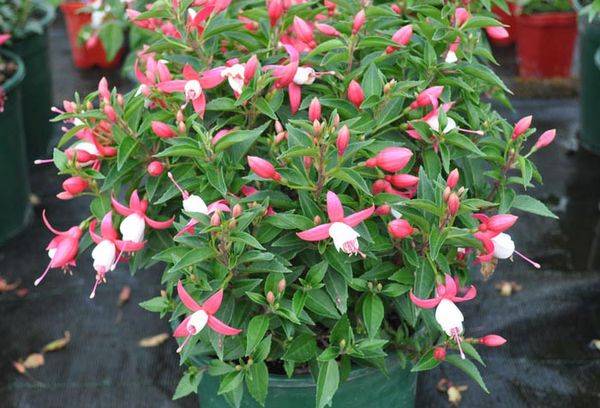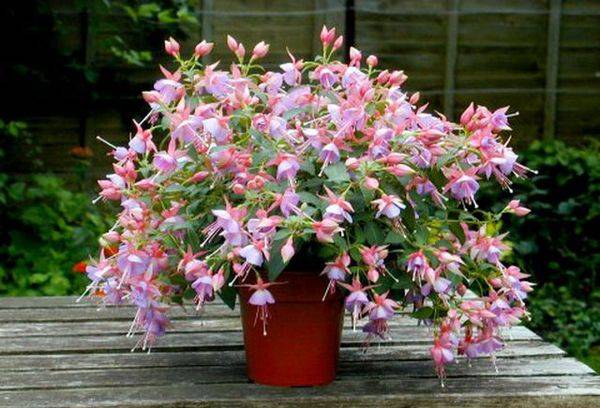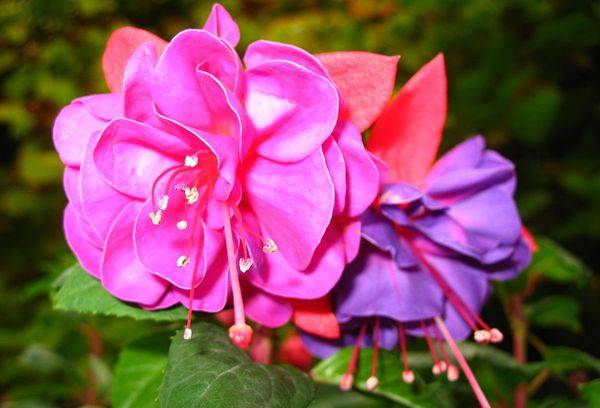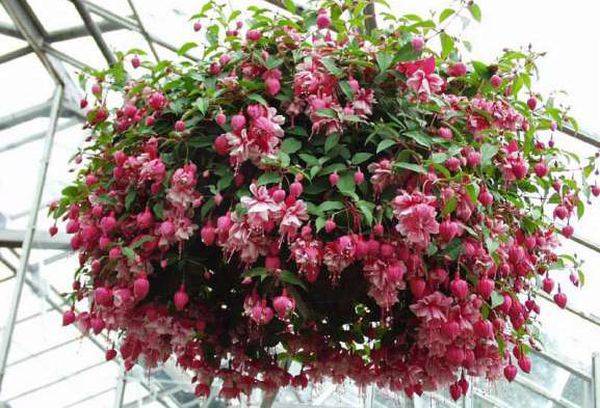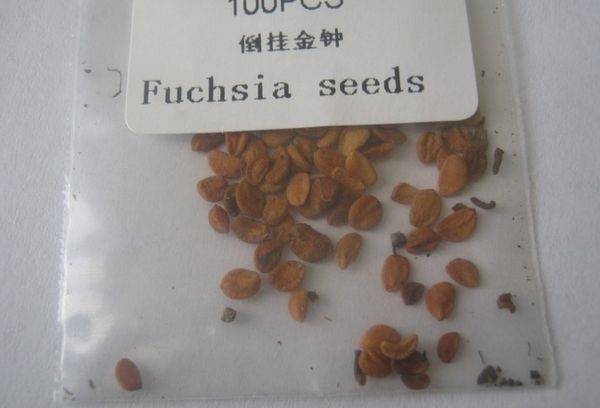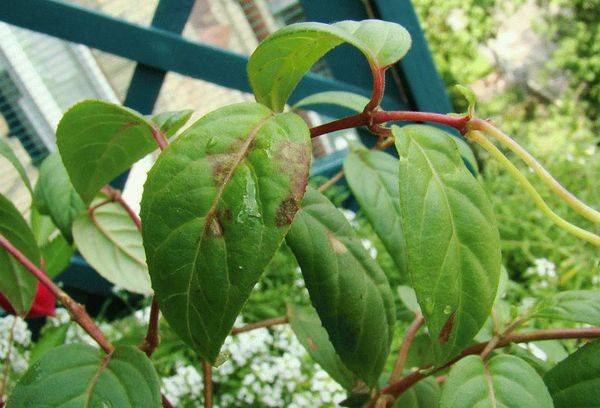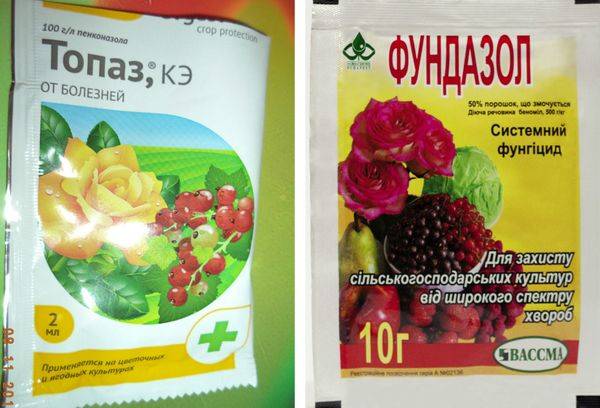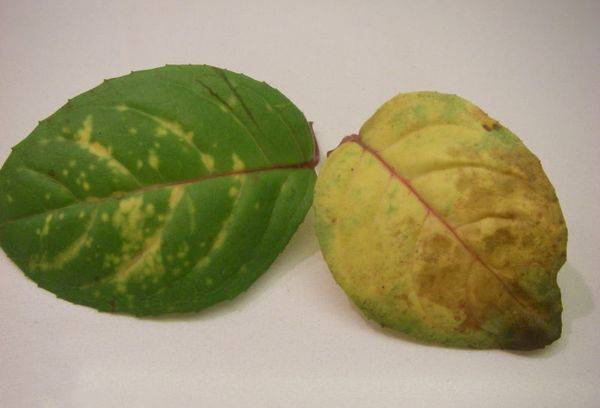What is interesting about fuchsia and how to care for it at home
Content:
For 200 years, various varieties and hybrids of this flower have been grown by flower growers - fuchsia is easy to care for and is resilient, although it can be capricious due to lack of attention. The main feature of the plant is its decorative effect. The bright colors of flowering delight owners and guests for a long time. What else is interesting about this flower?
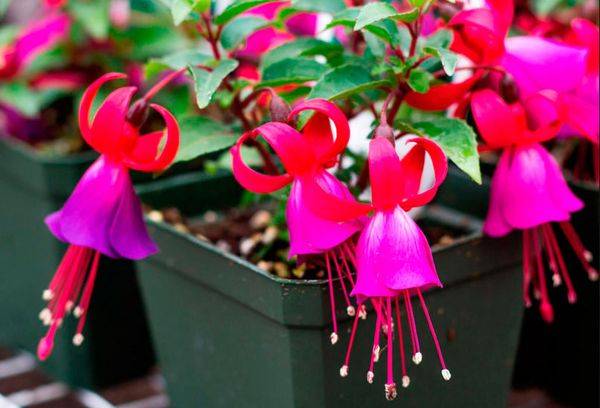
Ampelous fuchsia
Features of the flower
Fuchsia (Fuchsia) - an evergreen perennial from the fireweed family (Onagraceae). It came to the world of floriculture from the countries of Central and South America; some of its species are found in New Zealand. The plant is a shrub with flexible branches bearing opposite green leaves with jagged edges. The leaf length is about 5 cm, the shape is oval, with a pointed tip. At home, hybrid, or so-called indoor fuchsia (Fuchsia hybrida), which has many varieties, is grown. Some plant species are widely used in gardening and landscape design.
Drooping fuchsia flowers - the most valuable thing in the plant. They can be of different shapes, and the variety of shades is amazing. Fuchsias bloom at different times of the year, but more often from spring to autumn (this depends on the variety).Some gardeners grow collections of fuchsias: the flowering of one variety is followed by the flowering of another, and the result is a year-round blooming home garden.
Hybrid forms of fuchsia easy to grow. Many varieties easily agree to take any form: ampelous or woody. The structure of the flower evokes many associations, for which fuchsia has received interesting nicknames. This is a corolla-shaped calyx with a tubular corolla, from which long stamens protrude. The fuchsia flower resembles a ballerina's skirt, from under which neat legs in pointe shoes protrude.
The plant blooms for a long time. Flowers are small and large, double and smooth, single and collected in brushes. They are located on long stalks. The shades of the flower are very diverse: there are both monotonous and two-color hybrids, and there are varieties with three shades at once. Fuchsia colors: white, cream, orange, pink, lilac, red, violet and others.
Varietal diversity
In floriculture, there are about one hundred varieties of fuchsias. Breeders have obtained more than 20 thousand varieties and hybrids of flowers, but the work on developing new ones does not stop there. And they are all great to grow at home.
There are three main groups based on the type of growth:
- bush - shoots are straight and stretch upward;
- ampelous - freely hanging flexible stems;
- hanging-bush - long stems that need support.
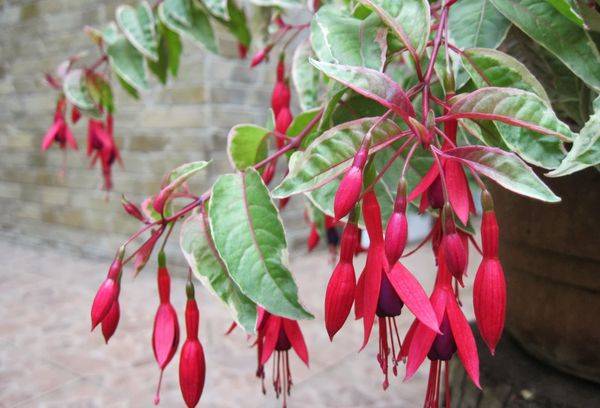
Fuchsia ampelous-bush
The most popular varieties suitable for indoor growing:
- Armbrough Campbell - a variety with winter flowering. Double flowers. The sepals are red, the petals are pale pink. Easy to care for, easy to reproduce.
- Alisson Bell - the owner of semi-double flowers of a red-violet hue.
- Henriette Ernst - fuchsia with large double flowers. The combination of scarlet sepals and a light lilac skirt attracts the eye.
- Waist - bush up to 60 cm in height. The flowers are deep orange. The flowering period is from spring to autumn. Suitable for creating flower arrangements.
- Imperial crown - flowers are elongated, pink-scarlet, collected in racemes.
- Blue Mirage - fuchsia with double, contrastingly colored flowers: the sepals are white with green tips, and the rounded skirt is purple. There are both bush and hanging ones.
- Hollies beauty - a variety with long flowers. The buds are colored soft purple (skirt) and white (sepals).
- Prince's Peace - peculiar coloring of flowers: white sepals favorably emphasize the red skirt.
- Bolivian - variety with flowers, collected in clusters. It is considered one of the most beautiful types of fuchsia. The flower has long peduncles - up to 30 cm, with gracefully hanging brushes of red or white flowers attached to them. The flowering period is short - from March to April. Bolivian fuchsia is thermophilic.
- Magellan - a very elegant variety, red-violet flowers resemble a Christmas tree decoration. The bush can reach 3 m in height. This fuchsia is used mainly for interior decoration: arches, windows, shop windows. Flowering - from March to October.
- Ballerina - the owner of a fluffy soft pink skirt and graceful scarlet sepals.
- Shining (shiny) - a variety that is beautiful not only with flowers, but also with green-purple leaves. From spring to autumn it pleases with elongated crimson flowers.
- Annabelle - huge double flowers of pure white hue.
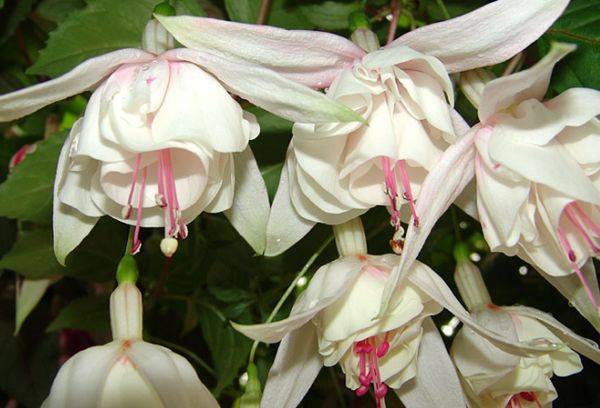
Fuchsia Annabelle
Fuchsia is not only grown indoors.Varieties for balconies and hanging cornices: cascade, Alice Ashton; Anita and Carolina varieties are grown in containers that are stored outside during the warm season. Fuchsia can also be successfully grown in open ground. A garden decorated with fuchsias is not a myth: in the summer the plant actively blooms, but for the winter it should be dug up and stored in a cool room.
Gardeners prefer the following varieties:
- capri, ultramarine, dark secret (flowers with white, blue and purple hues, the so-called sapphires and diamonds group);
- Matilda, Walsing (tall varieties of the Australian group);
- exotic terry varieties: Florentina, Sarah Jane.
Accommodation in the house
When caring for fuchsia, you need to take into account its seasonality. The growing season lasts from early spring to mid-autumn. In winter, the plant needs rest. Conclusion: at different times of the year, a flower needs different amounts of light, heat, water and fertilizer.
Bush fuchsias are grown in floor flowerpots. Hanging pots and baskets are intended for hanging varieties. It is advisable to choose a ceramic pot with thick walls so that the root system does not overheat. The color of the pot also matters: light colors repel the sun's rays, while dark colors accumulate heat, which is undesirable for the plant. There must be drainage holes at the bottom of the container.
When choosing a place for a flowerpot, give preference to a north, west or east window. Fuchsia is not a fan of bright lighting. Provide her with diffused light. For a flower growing on the north side, a little illumination with a lamp is recommended.
Fuchsias do not tolerate heat well. They are comfortable in cool rooms, with air temperatures up to +20⁰ C in summer and up to +15 in winter.If the temperature rises above +25, the flower turns pale and drops its buds. In such conditions he is most susceptible to disease. It is necessary to protect the plant from the summer stuffiness by taking it to the balcony or loggia in the morning. During the day and evening it is better to organize partial shade.
Humidity, watering, fertilizing
Regular watering is needed throughout the growing season. It is better to take settled or filtered water.
Advice
On hot days, spray fuchsia leaves with soft water, this will protect the flower from overheating. To keep the air constantly humidified, pour water into the tray or place wet pebbles.
What to do if you didn’t pay attention and the fuchsia leaves withered? These actions will help restore the crown’s elasticity and the whole plant’s healthy appearance:
- Water the soil generously;
- spray the bush with a spray bottle;
- cover with non-woven material.
The soil should not dry out between waterings. It is enough to wait for its top layer to dry - 1-2 cm. Excess water, which stagnates near the roots, is detrimental to the flower. With the onset of autumn, the amount of water decreases.
From spring to autumn is the right time to apply fertilizers - an actively developing plant needs nutrients. A sign that the flower does not have enough nutrition is the shallowing of the leaves and slow development. During the growing season, fertilizers are applied once every 2 weeks. For fuchsias, a complex fertilizer for flowering plants with a low nitrogen content is suitable. The magazine purity-en.htgetrid.com reminds that watering with fertilizer is carried out on slightly moistened soil, and foliar fertilizing is carried out on the back side of the leaf.
Flowering and dormancy
During the flowering period, it is advisable not to disturb the plant: do not rearrange the flowerpots or turn them, especially do not replant the fuchsia. When it blooms, it is adversely affected by any changes in care. In gratitude, the plant may shed its buds.
From the day the flowers begin to bloom until they last, fuchsia needs potassium and phosphorus - choose an appropriate liquid fertilizer and give it along with watering once a week.
After a comfortable winter, fuchsia blooms well. Provide her with the proper conditions:
- temperature - from +8 to +15 degrees;
- it is allowed to take the flowerpot out onto an insulated balcony;
- watering - 1-2 times a month;
- no fertilizing;
- removal of pests, if any.
Replanting, pruning
Every year the fuchsia is moved to a new pot. Fuchsia needs to be prepared in advance for moving to a new place of residence. To do this, preventative pruning is carried out: old, dried out and elongated shoots are removed, healthy ones are shortened by a third. Before planting fuchsia, make sure that its root system is not affected by disease. If rot is detected, it is cut off to healthy tissue.
It is easy to select soil for fuchsia. It grows well in a universal potting medium. Loose soil containing peat, sand and ash is preferable. To make your own substrate for growing fuchsia, take:
- leaf soil - 3 parts;
- peat - 2 parts;
- sand - 1 part.
Don't forget about the drainage layer. It should occupy at least 1/5 of the pot. The transplanted fuchsia is not watered for about three weeks.
Advice
The ideal time for replanting is early spring.
The pruning procedure will be useful not only before replanting.Periodic adjustment of the bush will provide the plant with a beautiful shape and abundant flowering. The first pinching can be done after the cutting has rooted. Then pruning is done every spring before flowering begins. Side shoots are pruned above every second or fourth pair of leaves. You can form a standard bush by securing the central shoot to a support and removing the side shoots.
Reproduction
Propagation by seeds is a difficult process that rarely brings good results. A plant grown from seed often does not retain all the properties of its parent. The vegetative method of propagation is used more often and more successfully. Such seedlings develop faster and begin to bloom earlier.
A cutting 10-20 cm long is cut off with a sharp knife and only the top pair of leaves is left on it. Apical and stem cuttings are separated during spring and summer. The stems should be slightly woody and the buds should be mature. If you had to separate the cuttings in autumn or winter, then the seedling needs to be provided with conditions close to summer ones.
The petiole takes root well both in water and in a sand-peat mixture. After 2 weeks, the first roots should form - the seedling is ready to be moved into a small container.
Advice
Don’t wait for the roots to grow; plant the fuchsia in the ground right away. If the container is large enough, you can plant several cuttings at once at a short distance.
Growing difficulties
Pests and diseases are a consequence of improper care. If you are attentive to your flower, you will avoid many problems. The main cause of the disease is excess soil moisture. No less rarely, diseases are provoked by a lack of nutrients and light.
Diseases and pests of fuchsia:
- Rust is brown round spots on the bottom of a leaf. Diseased leaves are removed, the plant is treated with Topaz.
- White flies. Pest larvae feed on plant sap. Treat the leaves with soapy water and use insecticides if necessary.
- Chlorosis - leaves turn yellow and dry out. Reduce watering in winter. Yellowing of the leaf veins indicates a manganese deficiency.
- Powdery mildew on leaves occurs from waterlogging of the soil. Treatment with Topaz or Fundazol will be required.
- If your plant is slow to develop, flowers quickly, and has a limp appearance, try increasing the amount of light and nutrients.
Adviсe
How to choose fuchsia seedlings in the store:
- Check for roots sticking out of the drainage holes.
- The leaves should be large. Even good-quality seedlings with small leaves take a long time to acquire the desired decorative appearance.
- Seedlings in the store should be stored in a well-lit place.
- Check to see if the proper amount is being watered. Dry soil is the beginning of flower diseases.
- Inspect the undersides of leaves for pests. If there are no spots or spots, feel free to buy the plant. To be completely sure, shake the bush slightly: what if whiteflies fly out of it? These insects are difficult to get rid of.
Fuchsia mysteries
Interesting facts about the flower: history, folk signs and beliefs, mentions in different areas of life.
- Flower growers call fuchsia “ballerina”, “gypsy earrings” or “Japanese (Chinese) lantern”.
- Fuchsia is one of the names for the shade of purple in the world of fashion and design. Some argue that the color name "fuchsia" includes all shades from light crimson to deep purple.
- Many types of flowers were named after a botanist or wildlife explorer. Fuchsia is no exception; it owes its name to no less than the “father of botany” - the German doctor Leonard von Fuchs.
- The fruit of fuchsia is a berry. It's edible.
- A relative of fuchsia is the fireweed plant, or fireweed, which is beneficial for humans. It is an excellent honey plant, a source of tannins and vitamin C.
- Popular superstitions say that fuchsia has magical properties. It is often recommended to grow it for people in creative professions. The plant awakens intuition and helps to find non-standard solutions. The flower harmonizes the space around itself and promotes a surge of energy. It is believed that fuchsia growing in the house smooths out conflicts and helps different generations reach mutual understanding.
- Fuchsia is a suitable plant for people with problems with the gastrointestinal tract and endocrine system.
- There is a version that fuchsia growing in the house of a lonely woman repels men. But this is just speculation: in many happy families, the windowsill is decorated with fluffy fuchsia skirts.
The variety of varieties allows you to choose fuchsia to suit every taste. You won't go wrong if you take one of the graceful "ballerinas" of the plant world as a gift for a florist. Fuchsia is an easy and pleasant place to start learning about floriculture. But be careful: you may want to decorate the entire space with dainty flowers.
